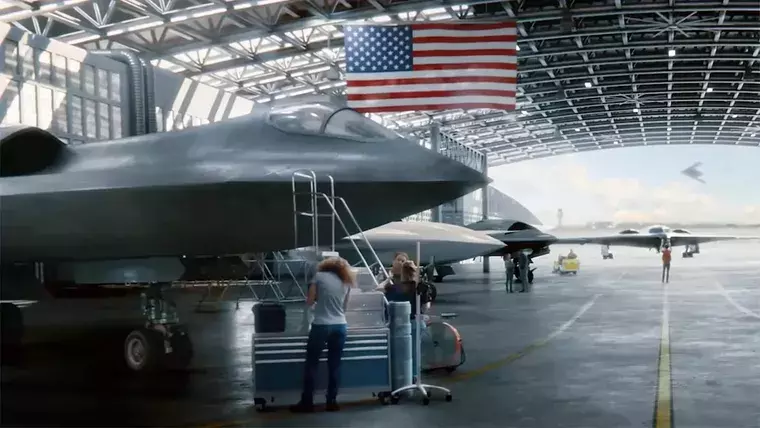Recent revelations are shedding light on a highly classified X-plane project, revealing it as a critical component in the Department of Defense’s (DoD) continuous advancement of the Next-Generation Air Dominance (NGAD) program.
The DoD believes that insights gleaned from testing the secret X-plane will lead to a significant leap in air combat technology, promising to reshape the future of aerial warfare.
In 2020, Dr. Will Roper, the then-Assistant Secretary of the Air Force for Acquisition, Technology, and Logistics, sparked a firestorm of curiosity when he revealed that the Air Force had already secretly built and flown a full-scale 6th-generation NGAD prototype.
“We’ve already built and flown a full-scale flight demonstrator in the real world, and we broke records in doing it,” Roper told Defense News in an interview ahead of the Air Force Association’s 2020 Air, Space and Cyber Conference. “We are ready to go and build the next-generation aircraft in a way that has never happened before.”
Additional details on this mysterious next-generation fighter aircraft have since remained shrouded in extreme secrecy.
However, on November 14, at the POLITICO Defense Summit, Air Force Secretary Frank Kendall shed more light on a previously undisclosed secret next-generation X-plane program, offering glimpses into the potential design and capabilities of America’s future air dominance fighter.
When Politico’s Lara Seligman asked what excited him most about the NGAD program, Kendall said it was the “family of systems approach.”
This “family of systems approach” mentioned by Kendall involves integrating various systems, such as autonomous drones, advanced weaponry like the classified AIM-260 Joint Advanced Tactical Missile, and external sensors, under the command of a single multirole fighter aircraft.
Kendall elaborated that the current NGAD program traces back to a 2014 study he commissioned as the Undersecretary of Defense for Acquisition, Technology, and Logistics. The study, entitled “The Dominance Initiative,” was carried out by the Defense Advanced Research Agency (DARPA).
“That study lasted a year or so and came back with a recommendation for a family of systems,” Kendall said. “That it was not just a fighter, so to speak, but also the fighter together with off-board sensor capability. Possibly uncrewed as well. New munitions, new and so-on, integrated into a package that would be the next generation of capabilities.”
While “The Dominance Initiative” remains classified, it prompted the Pentagon to launch a secret initiative dubbed the “Next Generation Air Dominance X-Plane Program.” Kendall said the secret program received “about $1 billion” in funding, divided between DARPA, the Air Force, and the Navy.
The Air Force and Navy have made it clear that each branch is developing its own next-generation fighter and will not be advancing a joint-service aircraft like the F-35.
The Navy has commonly referred to its future fighter as the “F/A-XX,” while the Air Force typically uses the NGAD title for its six-generation air superiority aircraft to emphasize the distinctions between their respective endeavors.
Nevertheless, the Air Force and Navy’s next-generation programs strangely carried the same official NGAD moniker.
Kendall’s comments clarify the mystery, revealing that each branch’s different overall design originates from technologies proven during the development of a jointly funded next-generation X-Plane program.
This also suggests that the “full-scale flight demonstrator” mentioned by Roper likely referred to the secret next-generation X-plane, which has served as a technology demonstrator rather than a fighter prototype.
However, adding more intrigue to the Pentagon’s mysterious efforts, Kendall indicated that the next-generation X-plane program resulted in the development of multiple full-scale fighter prototypes.
“That program, which we initiated during the Obama administration, produced some X-plane prototypes that were successful,” Kendall said. “[They] demonstrated the technologies that we need.”
The Air Force Secretary did not disclose how many aircraft were produced during the NGAD X-plane program. However, his use of “prototypes,” plural, suggests at least two or more full-scale designs had secretly taken to the skies in the last eight years.
In a July podcast, Vago Muradian, the editor-in-chief and host of the Defense & Aerospace Report, and J.J. Gertler, director of The Defense Concepts Organization and senior analyst at the Teal Group, reported that at least three NGAD fighter prototypes had already been built and flown.
Throughout the past year, aerospace industry titans Northrop Grumman and Lockheed Martin have also been teasing the existence of some full-scale next-generation X-plane designs.
In May, Northrup Gruman posted a 15-second ad on YouTube showing three women walking through an aircraft hanger. The ad discusses how women piloted and crewed the longest full-scale unmanned flight entirely. In the background of the hangar is a matte black, delta-winged aircraft.
The mysterious plane did not resemble any known designs. It had a single cockpit, no vertical tail section, and top-mounted low-observable air intakes, consistent features found on stealth aircraft.
Northrup Gruman has since removed the video from its YouTube channel.
In July, Lockheed Martin sparked intrigue and speculation by posting an Instagram story to mark the 80th anniversary of its renowned advanced projects division, Skunk Works. The story featured the silhouette of an unidentified, sleek, delta-wing crewed aircraft.
Unlike anything in Lockheed’s known inventory, many speculated the mysterious aircraft could be Skunk Works’ prototype sixth-generation fighter jet for the NGAD program.
Whether these enigmatic images shared by Northrop and Lockheed are glimpses of their next-generation X-plane prototypes or merely clever marketing remains a matter of speculation.
The Air Force released a classified solicitation for NGAD engineering and manufacturing development proposals in May. The service will select a single prime contractor to advance its NGAD design sometime in 2024.
Citing unnamed “sources involved in the program,” Muradian and Gertler said that Boeing and Lockheed Martin were still in the running for what will easily be a multi-billion dollar deal.
During a quarterly financial call in July, Northrop Grumman CEO Kathy Warden said the company would not pursue the Air Force NGAD contract. However, Warden indicated Northrop was open to competing to develop the Navy’s sixth-generation F/A-XX fighter.
While the final version of the Air Force’s NGAD fighter will likely remain cloaked in secrecy for some time, Kendall said it will be a descendant of the enigmatic prototypes fielded during the next-generation X-plane program.
“What we have funded now is the combination of a crewed aircraft that will have some of those technical characteristics that we demonstrated can be done,” Kendall said. “We’ve initiated the program to have uncrewed collaborative combat aircraft that will be controlled by that crewed aircraft- to fight as a formation, basically.”
“This family of systems approach we’re taking—also in the mix [are] our new weapons like the JATM, Joint Advanced Tactical Missile, which we’ll get into production in the next few years. So we’re going to have a very formidable next-generation air-dominance set of capabilities,” Kendall added.
“I think when we get that package filled, I’m really looking forward and excited about seeing that come to life.”
Tim McMillan is a retired law enforcement executive, investigative reporter and co-founder of The Debrief. His writing typically focuses on defense, national security, the Intelligence Community and topics related to psychology. You can follow Tim on Twitter: @LtTimMcMillan. Tim can be reached by email: tim@thedebrief.org or through encrypted email: LtTimMcMillan@protonmail.com

